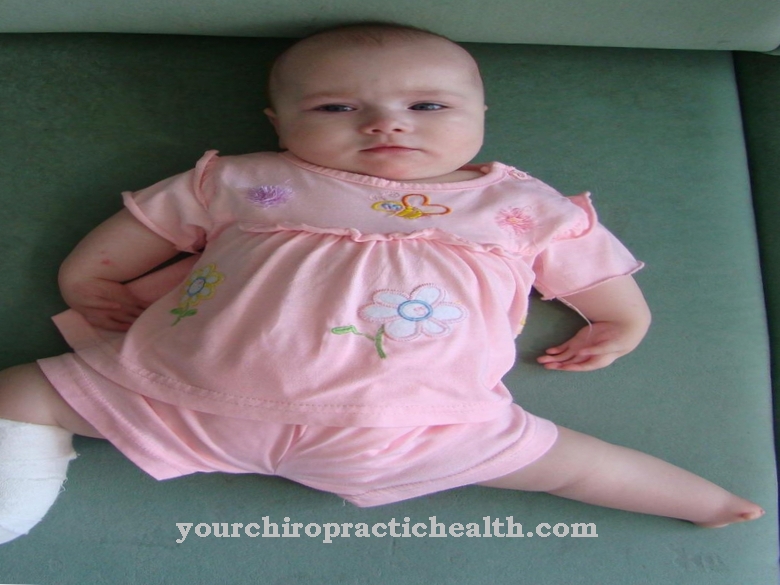A Eye infection is a bacterial, viral or fungal infection of the eye. Many individual areas of the eye can be affected and the symptoms and effects differ depending on the location and type of infection.
What is an eye infection?

Many viruses, bacteria, parasites and fungi that can invade the human body are also able to attack the surface of the eye or even penetrate deeper into the organ.
Depending on the infestation, the shape of the eye infection can vary greatly. The most common eye infection is viral infection. In most cases, it affects the inside of the eyelids or the inner corners of the surface of the eye. But blood vessels, retina, optic nerve or eye fluid can also be affected. Fungi mostly affect the blood supply to the retina.
Since the eye is a complex organ with many individual components, the possibilities for specific infections are wide-ranging. Eye infections are most common in young children. In many cases, these infections are also contagious.
causes
The causes of an eye infection can be numerous. The most common causes include histoplasmosis, chlamydia and gonorrhea, herpes virus.
Histoplasmosis is a fungal infection of the lungs that affects many people at least once in their lives, but often goes without serious side effects. Even years after the fungus is infected, it can migrate to the retina and cause damage there. Chlamydia and gonorrhea are common sexually transmitted diseases. An infection of the eyes can either come from direct contact with the infected genitals or from rubbing with the hands.
Herpes can cause an eye infection similar to chlamydia and gonorrhea. However, the danger to the eyes and the eyesight of the person affected are much more difficult to assess. Up to 15 percent of people who develop an eye infection caused by herpes complain of partial vision loss.
You can find your medication here
➔ Medicines for eye infectionsSymptoms, complaints & signs
In most cases, an eye infection is associated with very unpleasant complaints and symptoms and can therefore significantly reduce the quality of life of the person concerned. With an eye infection, patients primarily suffer from inflammation in the eye itself. The eyes are significantly reddened and can also be painful or itchy.
The itching often increases when the eyes are rubbed or when the eyes are stressed too much. The eye infection also leads to the formation of a crust on the edges of the eyes and thus to the eyes sticking together. These symptoms can become more severe, especially in the morning or before going to bed.
The eyes themselves are swollen and painful with an eye infection. The pain often spreads to the head or ears. Furthermore, if left untreated, an eye infection can also negatively affect and reduce the eyesight of the person affected.
In the worst case, this can also lead to complete blindness. The immune system of the person concerned is generally weakened by this infection, so that the person concerned is susceptible to various diseases. The everyday life of the person affected is also negatively affected by this infection.
Diagnosis & course
Eye infections trigger relatively unspecific symptoms. Even after precise laboratory tests, the diagnoses are often not very clear.
A yellowish or brownish discharge from the eye is often a sign of bacterial attack. These bacteria can have gotten to the eye through feces, animal hair, smoke, or other scents. Itchy and bulky eyes are often a symptom of allergic infections. An infection that looks less infected (more pink than red) often indicates a viral infection.
Blurred vision and an altered perception of light are common with eye infections; mostly caused by the excreted fluid. When diagnosing it, particular care should be taken to rule out other diseases that produce similar symptoms, such as glaucoma, uveitis, and keratitis.
Complications
An eye infection can lead to inflammation of the eye, which can also fester. A distinction must be made between various diseases, all of which have similar complications. In the eye, the conjunctiva in particular is affected by inflammation. From there, the infection can spread and spread to other structures on the eye, such as the cornea or the eyelid.
The eyelid can be misaligned and turn inwards (entropion), causing a foreign body sensation. In addition, the eyelashes rub against the eyeball (trichiasis), so that the symptoms worsen. The cornea can become dangerously cloudy, which initially affects the eyesight and in the worst case can lead to blindness.
In addition, chronic inflammation can lead to the formation of scar tissue (pannus) in the cornea and conjunctiva, so that the eyesight is also restricted here. The pannus can also occur in the area of the tear ducts. As a result, the eye is no longer properly moisturized and dries out, making it painful and more susceptible to infection.
In general, an infection of the eye is caused by various pathogens. One of the most common consequences that develop is a weakening of the immune system and thus an increase in the risk of another pathogen infecting the eye, the so-called superinfection. This makes it even more difficult to treat the eye and increases the risk of blindness.
Treatment & Therapy
In the case of allergic eye infections, cooling helps with acute symptoms. In worse cases, anti-inflammatory drugs may be necessary. If the allergy occurs more frequently, antihistamines should be taken. Bacterial infections usually resolve without treatment.
Antibiotics or eye drops are only necessary if the infection does not go away after three days. However, using antibiotics immediately can speed healing of the eye infection by over a day. A special exception to bacterial eye infections is infection by chlamydia. This sexually transmitted disease is the most common cause of blindness and will not heal without the use of antibiotics. Viral infections also usually heal after a few days.
One possible treatment for eye infections caused by histoplasmosis is to cauterize the affected tissue. This repeated cauterization or burning of the tissue prevents the fungus from causing further uncontrolled damage. However, damage that has already occurred cannot be healed.
Doctors & therapists in your area
Outlook & forecast
An eye infection usually heals within a few days without any consequences. Prerequisite for this is an immediate treatment of the inflammation with eye drops, which, depending on the causative agent, contain an antibiotic or cortisone. Occasionally, spontaneous healing is also possible without medical help. If an eye infection with severe symptoms such as pus formation, swelling and redness is not treated, it can spread within the eye and lead to permanent visual damage.
The prognosis should also be made carefully if the eye infection is based on a weak immune system caused by another disease. In these cases, a cure depends on whether the underlying disease has been successfully combated or at least can be effectively controlled. The patient's behavior can also have a decisive influence on the healing process.
Poor hygiene, such as not washing your hands before administering the eye drops or rubbing your eyes constantly, lead to the spread of germs, causing the infection to flare up again and again. In addition, the eye drops must be introduced into the eye several times a day as instructed by the doctor to ensure that they are effective.
The use of contact lenses during an eye infection puts the success of the treatment in question, as does staying in dusty rooms and strong sunlight or light. Consistent adherence to the therapy recommendations and protection of the eyes significantly improves the chances of recovery.
You can find your medication here
➔ Medicines for eye infectionsprevention
The best prevention against most types of eye infections is caution. Most infections are caused by the hands in the eyes. When dealing with infected people, care should be taken not to pick up possible carriers in the hands and distribute them on your own face. Of course, this also applies to sexual intercourse with infected people. Washing utensils such as towels should generally not be shared.
Aftercare
Follow-up care should, among other things, prevent possible complications of an eye infection. However, this severe form of the disease is the exception. Risks only arise when the eye is seriously affected. Redness and pus then spread in the eye. Doctors prescribe antibiotics to prevent lasting damage.
A final check-up will then take place. The doctor sometimes also examines the retina. A blood test can provide information about the spread of the disease. Furthermore, the aftercare basically aims to support the sick person in coping with their life in everyday life.
This is not necessary because the eye infection subsides within a short time. Sometimes, however, cause research is carried out. In the case of frequent infections in particular, the attending physician points out that hygienic standards are being observed. Patients should never hold eyes with unwashed hands. Bacteria and viruses find their way to the organ of vision.
An eye infection is usually treated on an outpatient basis by an ophthalmologist. In the majority of cases, there is no follow-up because the medication is completed within a few days. There are no longer any complaints. The patient resumes his normal life without any restrictions.
You can do that yourself
If a serious infection has occurred in the eye area, treatment by an ophthalmologist is essential. Rapid treatment can quickly relieve symptoms in the eye. If the eye infection is serious, anti-inflammatory drugs are used to treat it. Medical treatment is usually not necessary for bacterial infections. Thanks to the self-healing powers of the human body, a bacterial infection can clear up without treatment.
In order to make the time until recovery more pleasant, the use of harmless but effective home remedies is recommended. Eyebright tea is an effective way to relieve eye irritation and heal infections. Drinking tea can promote healing from within.
If the eye infection is accompanied by severe swelling of the eyelids, treatment with fennel is a sensible option. The fennel has a calming, mild and decongestant effect and can also be easily used on children. Chamomile tea is a well-known home remedy for the treatment of eye infections. With a saline solution from the pharmacy, you can disinfect and moisten your eye area so that the eye infection can be relieved quickly.
However, if the home remedies do not provide relief after a long period of time, those affected should consult a doctor and have the problem treated by a specialist.
























.jpg)



